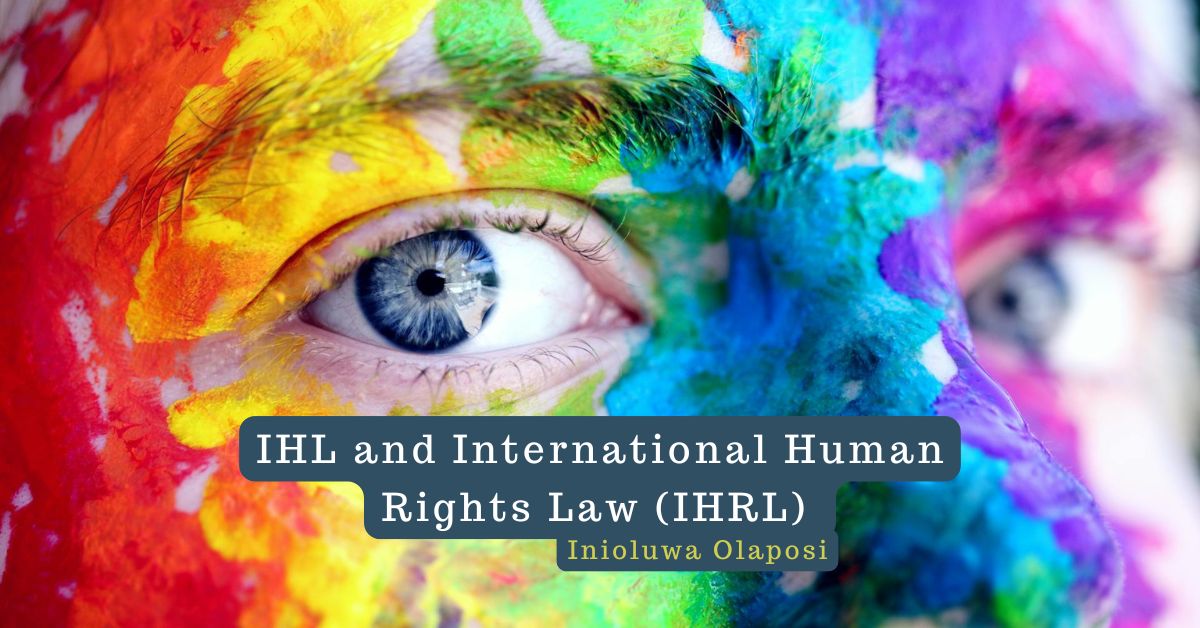IHL and IHRL
International Humanitarian Law (IHL) and International Human Right Law (IHRL) are both branches of public international law that seek to protect the lives and dignity of people.
Though IHL and IHRL or human rights law are similar on certain grounds, they are also distinct. IHL is different from human rights in origin, scope and application.
Human rights law is a set of international rules that have emerged from customs and treaties for the recognition and protection of certain rights that accrue to individuals or groups by their State. IHRL therefore operates vertically. It applies at all times, but can be subject to certain derogations.
International Humanitarian Law, on the other hand, is a branch of public international law that seeks to protect civilians and persons no longer participating in hostilities, and restrict the means and methods of warfare. It applies only in times of armed conflict.
IHL has a more ancient history than human rights law, in terms of recognition and application. IHL has its deep roots in ancient manuscript and was codified in the second half of the 19th century. Though IHRL can be traced to certain ancient documents such as the Magna Carta of 1215, United States Declaration of Independence in 1776, the French Declaration of the Rights of Man and of the Citizen in 1789, etc., it only emerged as an aspect of international law after the second world war in the 20th century.
The String and the Confusion
Getting to understand the relationship between human rights and IHL may pose some understandable confusions. Why have IHL at all if human rights apply in all situations? Is IHL provided for the failure of human rights law?
The simplicity of these questions require a careful consideration of what IHL specially provides for, and how it does so. There are some aspects of IHL that we do not find in IHRL at all. These include the status of ‘combatants’ and ‘prisoners of war’, the use of protective emblems, and the legality of certain means and method of warfare. Similarly, there are many identifiable aspects of human rights law that are not within the scope of IHL.
So what do we have? IHRL is a body of laws that protects humanity in both peacetime and wartime. While IHL is a body of rules that make special provisions for certain protected persons and objects, given the realities of armed conflict and its despicable effect on humanity and the environment.
A flip view at when violations occur can also help understand the two. Killing or homicide is a violation of the right to life and therefore an offense in human rights law. Killing, however, is generally legitimate under IHL given that the ‘victim’ was directly participating in hostilities. IHL can also allow the killing of or assaults against persons not directly participating in hostilities given an anticipated concrete and direct military advantage and adequate precaution taken.
Thus, IHL and IHRL are different but complementary. Identifying when each or both apply rely on an analysis of the situation at hand. This can be highlighted using the following headings:
1. Object of Protection
Human rights law, designed primarily for peacetime, applies to everybody within the jurisdiction of a State. International humanitarian law was created for the protection of persons who are not or are no longer taking direct part in hostilities.
Therefore, unlike under human rights law, the armed forces of a State in an armed conflict or fighters of a non-State armed group are not protected persons under IHL. They are rather persons against whom defined kind of assaults may be targeted. In other words, lack of protection does not mean any means of attack can be used against them. But they can be attacked and in fact killed.
IHL protects civilians and combatants who are hors de combat.1 The latter category are combatants that are no longer taking direct part in hostilities, such as the wounded, sick, shipwrecked, prisoners of war or those that have willfully surrendered.
2. Parties bound by IHL and IHRL
IHL creates a horizontal relationship in which all parties to a conflict are equally obligated to abide by its rules for the sake of protected persons. In other words, both States and non-State actors are obligated to keep IHL. A violation of international humanitarian law is known as a war crime.
Human rights law governs the relationship between a State and persons within its borders. Thus, human rights law, as earlier highlighted, creates an essentially vertical relationship. IHRL bind only States for the benefit of persons within their territory.
Nevertheless, a non-State armed group may also be bound by human right if it has the ability to act like a state authority usually by virtue of stable control of a territory.2
3. Time and Place of Application
Human rights law applies at peacetime and during armed conflict. IHL applies only during armed conflict.
Also, human rights law applies generally within the territory of a country. IHL, however, may apply between two or more states, between a states and a non-State armed group, or between such groups within a state. IHL, thus, applies extraterritorially by default. Nevertheless, human right can also apply extraterritorially where a State, by invitation or force, assumes control over a foreign territory.
4. Derogations in Application
It is a generally accepted legal truth that human rights can be derogated from. This happens in exceptional circumstances, such as during a public emergency that threatens the security or life of a nation. States, the sole entities bound by human rights law would usually consider the interest of the nation in general over that of a single individual.
For example, Article 4 of the International Covenant on Civil and Political Rights (ICCPR) provides, “In time of public emergency which threatens the life of the nation and the existence of which is officially proclaimed, the States Parties to the present Covenant may take measures derogating from their obligations under the present Covenant to the extent strictly required by the exigencies of the situation…”
However, because international humanitarian law applies only during armed conflict, no derogation from its obligations are permitted.
It is important to mention that some human rights may also not be derogated from at any time. These include the right to life, freedom from torture or cruel, inhumane or degrading treatment punishment, freedom from slavery and servitude, etc.
5. Applicable laws
IHL also differs from IHRL in terms of the laws that apply to them. Some of the main treaties that provide for human rights law include the International Covenant on Civil and Political Rights (1966), the International Covenant on Economic, Social and Cultural Rights (1966), Convention on the Prevention and Punishment of the Crime of Genocide (1948), Convention on the Rights of the Child (1989), Convention on the Rights of Persons with Disabilities (2006), etc.
The main treaties that provide international humanitarian laws are the four Geneva Conventions of 1949 and their additional protocols. Customary International Humanitarian Law (CIHL) also plays a significant role especially in situations of an armed conflict not of an international character.
Conclusion
IHL and IHRL are two branches of public international law that are distinct but complementary. IHRL applies at all times (Lex generalis), while IHL applies only in situations of armed conflict whether of an international or non-international character (Lex specialis). But because these two aspects of law are complementary and contain certain similar provisions, they may overlap. Nevertheless, they are very different in scope and application.
1A French term meaning ‘out of combat/action’.
2“What Is the Difference between IHL and Human Rights Law?” (International Committee of the Red Cross, December 16, 2019) <here>
About Author
Inioluwa Olaposi is a graduate of Obafemi Awolowo University, Ile-Ife. He was part of a team of three that won the National International Humanitarian Law Moot Competition for Nigerian Universities and subsequently participated in the All-Africa Regional Rounds at Nairobi, Kenya.



Leave a Reply